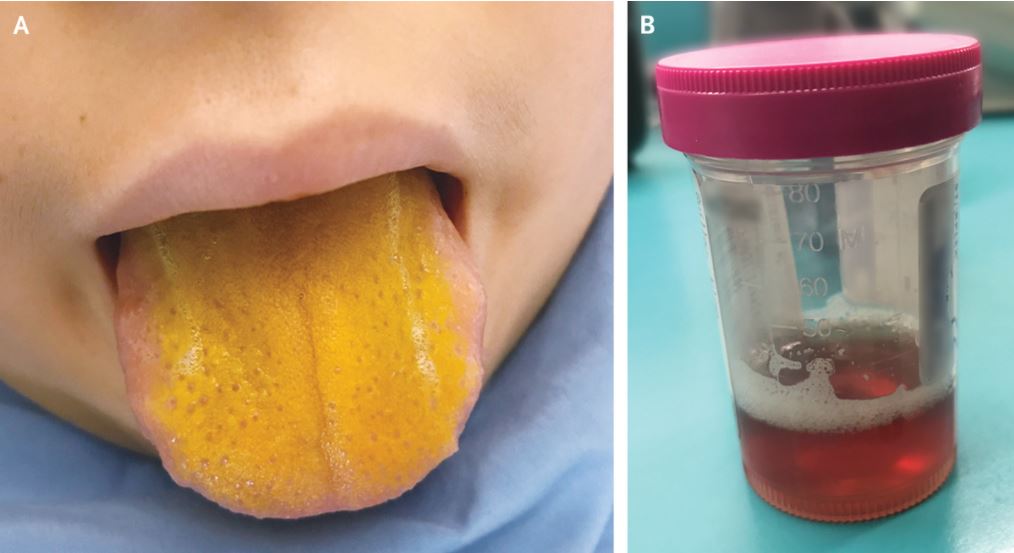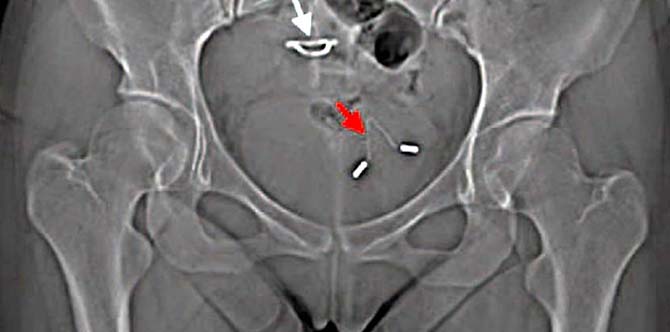We look at ten bizarre medical instances, ranging from yellow tongue to magic mushrooms growing in a man’s blood.
1 Sinuses with chopsticks

After a violent battle with her sister, a woman in Taiwan had chopstick fragments buried in her sinuses for a week without realizing it.
According to a case report published June 24 in The Journal of Emergency Medicine, the 29-year-old lady went to the hospital after being “attacked by her sister with plastic-wood chopsticks while at the dinner table.” Doctors discovered two minor cuts behind her eye and on her nose, but an X-ray revealed no abnormalities.
However, the woman began to suspect that her injuries was more serious than it appeared one week later. She thought she saw a gray thing in her nose when she looked in the mirror. A second inspection indicated that fragments of chopstick had pierced her nasal septum, the wall that separates the two nasal passageways. A CT scan revealed two chopstick fragments in her sinuses, one of which was more firmly entrenched than the other.
According to the story, the woman underwent surgery to remove the shards, which were around 1.4 inches (3.5 cm) and 2 inches (5 cm) long, respectively. She had no post-operative problems.
2 Yellow tongue

A yellow tongue isn’t normally cause for concern, as it can be
caused by a variety of factors ranging from a dry mouth to poor oral hygiene. A yellow tongue, on the other hand, was an indication of a serious and unusual
disease for a 12-year-old kid in Canada.
According to the article published on July 24 in The New England
Journal of Medicine, the youngster went to the hospital after experiencing a
sore throat, dark urine, abdominal ache, and pale complexion for several days.
He had a vivid yellow tongue as well. Doctors discovered the boy had jaundice,
a condition that causes a yellowing of the skin and whites of the eyes, as well
as dark urine and, in rare cases, death.
When the yellow chemical bilirubin accumulates up in the body,
it causes jaundice. Bilirubin is produced when red blood cells are broken down
normally. What, though, was the source of the boy’s jaundice?
Doctors discovered the youngster had cold agglutinin disease, a
rare autoimmune illness in which the immune system attacks and kills the
person’s own red blood cells after a battery of testing. Because exposure to
cold temperatures triggers an autoimmune assault, symptoms can be exacerbated during the winter months. Because of the rapid disintegration of red blood
cells, a buildup of bilirubin occurs, resulting in anemia and possibly
jaundice. Cold agglutinin illness can be
caused by a variety of viruses, including Epstein-Barr virus infections. The
youngster was revealed to have an Epstein–Barr virus infection, which his
physicians believe is what caused his cold agglutinin sickness.
The youngster required a blood transfusion and was given oral
steroids to suppress his immune system. The youngster “recovered
nicely” after leaving the hospital, according to the authors, and his
tongue color progressively returned to normal as his blood bilirubin levels
dropped.
3 Inside a man’s eyes, copper ‘rings’

A man’s eyes revealed crucial information about his unusual condition. An eye exam revealed golden-brown rings encircling his irises in both eyes when the man, who resides in India, went to the doctor with abdominal bloating.
According to a case report published Sept. 25 in The New England Journal of Medicine, doctors found that the patterns were Kayser–Fleischer rings, which are formed by a buildup of copper in the cornea, the eye’s transparent outer layer.
Wilson’s disease is characterized by Kayser–Fleischer rings, which are an indication of a rare disorder known as Wilson’s disease. According to the National Institutes of Health, people with Wilson’s illness have a genetic mutation that prevents them from excreting excess copper, resulting in a buildup of copper in the body, particularly in the liver, brain, and eyes. The illness affects around one out of every 30,000 persons.
Copper poisoning can cause difficulties with the liver, kidneys, and nervous system. Cirrhosis, or scarring of the liver, had occurred in the man’s instance. The individual was given a chelating agent, which is a drug that removes copper from the body. According to the article, he was also put on a waiting list for a liver transplant due to his severe liver damage.
4 A BB gun pellet stuck in the teen’s nose.

For eight years, a teen had an accidentally lodged BB pellet in his nostril, causing a “foul odor” when he blew his nose.
When he was 15, the adolescent went to the doctor for the first time because of his ailments. According to a case report published Feb. 18 in the journal JAMA Otolaryngology–Head & Neck Surgery, he had been suffering from nasal congestion and a diminished sense of smell for several years.
For his symptoms, he was given a nasal spray and antihistamine medication at first. The authors reported “a distinct, unpleasant odor” that filled the room when he blew his nose a year later when he returned to the doctor.
In his nasal cavity, a CT scan revealed a 0.35-inch (9-millimeter) spherical object. The object, which turned out to be a metallic BB pellet, was surgically removed from the teen. A conversation with the teen’s relatives revealed that when he was about 8 or 9 years old, he was shot in the nose with a pellet pistol. Because the boy had no symptoms at the time, his parents did not seek medical help.
Because new tissue had developed over the pellet, it was difficult to see at first. According to the authors, it had clogged the drainage routes in the boy’s nose, resulting in an accumulation of mucus, debris, and germs, which generated the unpleasant odor. Following the boy’s surgery, the unpleasant odor disappeared.
5 Magic mushroom fungus grew in the bloodstream of a man

After injecting a tea derived from “magic mushrooms” into his veins, a guy acquired a life-threatening infection in his blood.
According to a case report published Jan. 11 in the Journal of the Academy of Consultation-Liaison Psychiatry, the 30-year-old man had bipolar disorder and opioid use, and he had been exploring for ways to self-treat his symptoms. He planned to make a ‘shroom tea’ by boiling magic mushrooms, which contain the hallucinogenic chemical psilocybin, and injecting the tea into his body.
The man had nausea and a darkening of his complexion after that, and he began vomiting blood. The man was taken to the hospital by his family, where testing revealed that several of his organs, including his liver and kidneys, were failing. He had a blood infection caused by the fungus Psilocybe cubensis, the species of magic mushroom the man had injected, according to further testing. In other words, the fungus was developing in his blood, according to the authors.
Antibiotics and antifungals were used to treat the individual, and he needed to be put on a ventilator due to respiratory failure. He was well enough to leave the hospital after 22 days.
6 The IUD gets stuck in a woman’s bladder.

The intrauterine device (IUD) that a lady had received a decade previously had “eroded” through her uterus and into her bladder, resulting in blood in her pee.
After having two children, the woman obtained the IUD at the age of 37. According to a case report published in the January issue of the journal Case Reports in Women’s Health, doctors suspect the IUD perforated her uterus and subsequently her bladder over time, causing her bladder symptoms when she was 47 years old.
IUDs are long-lasting birth control devices that can last up to 12 years. However, the devices can perforate the uterus in rare situations, which occurs in roughly 1 in 1,000 women who receive an IUD. Perforation of the bladder is very rarer.
Doctors discovered a “bladder stone” measuring 0.43 inches (1.1 cm) on part of the device in the woman’s instance. The bladder stone was pulverized and the IUD was removed by doctors.
7 Cowpox was transmitted to a woman by her pet cat.

In the United Kingdom, a lady Cowpox, a cousin of smallpox, caused a severe eye infection, which she caught from her pet cat.
Doctors worried the 28-year-old woman might lose her vision due to a severe eye infection. According to a case study published in The New England Journal of Medicine on June 5, despite receiving a plethora of antibiotics, nothing seemed to work.
Surprisingly, the patient’s pet cat had developed strange sores on its paws and head two weeks prior. Cowpox was found in both the cat’s lesions and the woman’s eye. Cowpox is a rare viral disease that can infect a variety of animals, including cows, cats, and people. It has a lot in common with the vaccinia virus, which is used in the smallpox vaccine. Cowpox transmission from cats to humans is extremely uncommon, with only a few cases ever reported.
The woman was given the antiviral medicine tecovirimat, which her doctors had procured from the United States. National Strategic Stockpile The stockpile comprises 2 million doses of tecovirimat, which will be used in the event of a smallpox bioterror strike. Her infection was cleared by the medication.
8 A 4-inch piece of cement was found in the man’s heart.

Following a spinal operation, a guy experienced an unusual side effect: a 4inch chunk of cement lodged in his heart.
According to a case report published in The New England Journal of Medicine on Oct. 2, the 56-year-old man went to the emergency room after experiencing chest pain and difficulty breathing.
The man had recently undergone spinal surgery to cure a vertebral compression fracture, which is a painful disorder in which a portion of a spine bone (vertebra) collapses in on itself. The man had a kyphoplasty, which involves surgeons injecting a particular form of cement into the vertebra to restore its appropriate height and prevent it from falling.
The cement can leak from the bone into other regions, causing a blockage or embolism of a blood artery. The cement spilled from the man’s bone into his veins, hardening and embolizing as it traveled to his heart, according to the authors. The cement embolism was removed, and a tear in his heart was repaired by doctors.
9 A tropical disease was found in a fish tank.

Diseases can be transferred by even pet fish. A woman in Maryland, for example, developed a rare bacterial sickness from her aquarium at home.
Melioidosis is a tropical disease that is usually exclusively seen outside of the United States. The woman’s case is exceptional since she had never gone outside the United States before, according to a paper published in the journal Emerging Infectious Diseases on Sept. 27 this year. According to the authors, her case is also the first in the world to be linked to a home aquarium.
The 56-year-old Maryland woman was admitted to the hospital with a fever, cough, and chest pain in September 2019, and tests revealed she had pneumonia. Further testing confirmed she was infected with Burkholderia pseudomallei, the bacteria that causes melioidosis, a few days later. To get rid of the illness, she had to take antibiotics for 12 weeks.
Health experts examined samples from inside and outside the woman’s home, including samples from her two freshwater aquariums, which contained tropical fish, to figure out where her infection came from. B was found in one of the fish tanks’ samples. pseudomallei, and the bacterial strain in the tank matched the one that infected the patient genetically. The illness could have been transmitted when the woman cleaned the tank with her bare hands.
10 Like a muscle, man can control his pupils.

A young man in Germany has a unique talent: he can enlarge and constrict his pupils on command, an act previously deemed impossible by researchers.
Researchers assumed it was difficult for people to directly regulate their pupils like a muscle since their pupils dilate and contract spontaneously in response to dark and bright settings. According to a case report published Aug. 12 in the International Journal of Psychophysiology, the 23-year-old man proved researchers wrong: multiple tests showed he could voluntarily dilate and constrict his pupils on demand, without using mental tricks like thinking about a dark or bright environment. To achieve the trick, the man just concentrates on his eye, which he claims he has developed since he was a youngster. The individual told the researchers, “Constricting the pupil feels like clutching, tensing something; expanding it larger feels like entirely releasing, relaxing the eye.”
The authors are now investigating whether additional people could learn to exert such control over their students.
